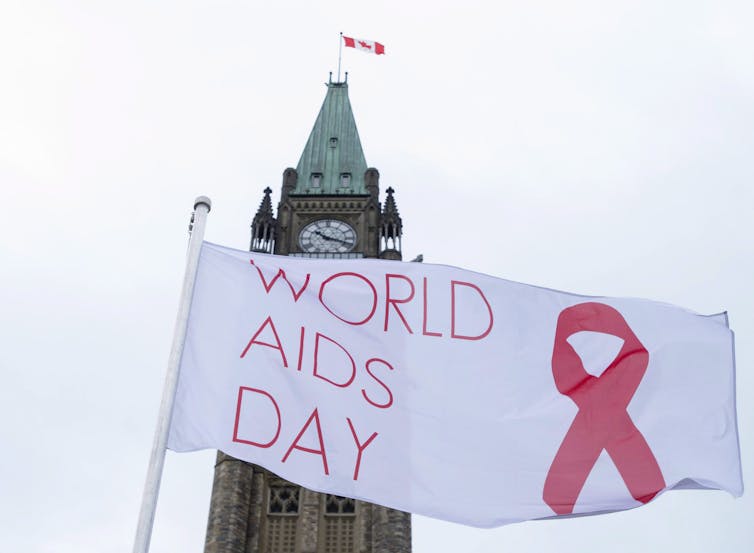A ray of hope on World AIDS Day for Canadian immigrants
Published: December 1, 2017
ItŌĆÖs World AIDS Day and this year, I am moving beyond remembering loved ones. I am shifting to a forward position and a distinct political hopefulness.
My wish on this World AIDS Day is for Canada to change how HIV is dealt with in its immigration system. Specifically, I would like to see the nation change how it makes inadmissibility decisions about people with HIV who apply to live in Canada.
This would be done through the Department of Immigration, Refugees and Citizenship. It would involve changing specific institutional practices, including the collection and circulation of HIV-related data from prospective immigrants.
The imperative for my research is to demystify social institutions like immigration so that we can explore and understand how things happen. As an interdisciplinary professor in health and social justice, and as a former social worker in a womanŌĆÖs sexual health communitiy, .
For the past 15 years, I have been involved in AIDS work. I have worked in the Horn of Africa and parts of Canada in direct support. My life and lives of people I care about, some of whom cannot immigrate to Canada because of their HIV status, are deeply affected by this infection and its unfortunate pernicious social standing. I work with teams to use .
Using creativity and critique
This is precisely what I have done for CanadaŌĆÖs mandatory immigration HIV testing policy. The policy was enacted in 2002, but not ever reviewed until my work.
The policy acts as a filter. It screens for HIV and sorts people with HIV out (with some exceptions). HIV is discovered in the medical examination that all applicants for permanent residency must undergo at regular intervals. Most of these exams happen outside of Canada in contexts that Canada cannot monitor.
My motivation for assessing how this policy functions in everyday lives was because of the disconnect between immigrant peopleŌĆÖs everyday social experiences through CanadaŌĆÖs imposed HIV testing, and the official representations of these experiences.
I formed alliances with racialized women with HIV from the Global South coming through . Through them, I learned of the contrast between what actually happened in their lives with immigration medical processes and what is officially understood to have happened as documented in national government reports.
I set out to understand how this dissonance was happening. All persons aged 15 years and older who request Canadian permanent residence, such as refugees and immigrants, are required to undergo HIV testing. Tuberculosis and syphilis are the two other conditions for which people receive mandatory screening.
I produced . I identified both inequities and levers for change.
An immigration HIV test catalyzes the stateŌĆÖs collection of medical data about an applicant. These are entered into state decision-making about the personŌĆÖs inadmissibility to Canada.
The good news on HIV policy
As it turns out, the HIV policy and mandatory screening ushers in a set of institutional practices that are highly problematic for prospective immigrants with HIV infection, the Canadian state and what is means to be Canadian more broadly. .
The good news is that policies can be adjusted.
People with disease and disability, and their advocates, recently met with Immigration Minister Ahmed Hussen to discuss and plan a future course of action.
And we have recently learned that Hussen has said ŌĆ£.ŌĆØ

CanadaŌĆÖs Immigration Minister Ahmed Hussen says current medical inadmissibility rules for newcomers are out of touch with Canadian values and need to be reformed (photo by Adrian Wyld/The Canadian Press)
It was acknowledged that the ways in which medical inadmissibility decision-making is informed and practised are outdated. This certainly applies to .
We see that HIV infection is scrutinized more and differently than any other health condition through the immigration process, where we see layers of institutional directives, guidelines and practices in place governing HIV/AIDS. .
. Research on the social determinants of health shows us that we all live better lives in egalitarian societies. Part of how to achieve such societies is how we talk and listen to each other.
What sort of public spaces can we create to hear and be heard on matters related to the Canadian immigration system and medical inadmissibility decision-making? Opportunities are preciously few.
A roundtable on immigration and disease is needed
I propose a roundtable on immigration, disease and disability in which I bring to the table the most up-to-date scientific knowledge about immigration and HIV. We could invite HarvardŌĆÖs Professor Michael Sandel to join, because he also asks critically important questions about immigration (and sparks debate to collectively contemplate answers), as well as my colleagues at the . When can we meet to discuss immigration and HIV?

The World AIDS Day flag flies on Parliament Hill in Ottawa last Dec. 1 (photo by Justin Tang/The Canadian Press)
Together in class, students and I have used the research record to . We have done the same regarding within CanadaŌĆÖs immigration system.
Just as other immigrants to Canada do, those with HIV will contribute to our society in myriad ways. Having interacted with thousands upon thousands of people with HIV over time and across space and place, they are among the most resilient and hard-working people I have met, which I attribute to the experience of personal suffering and knowledge of the larger social and political history of HIV/AIDS, not to mention their place within it.
This is precisely the sort of immigrant that Canada wants and indeed welcomes.
I am committed to a process in which we can talk with and listen to each other on matters of immigration and disease as they relate to HIV/AIDS. The moment is upon us to work with the most up-to-date scientific evidence to produce a medical inadmissibility decision-making system unfettered by inducing harm.
is an assistant professor in the health studies program of the department of anthropology at the University of Toronto Scarborough.
This article was originally published on . Read the .



